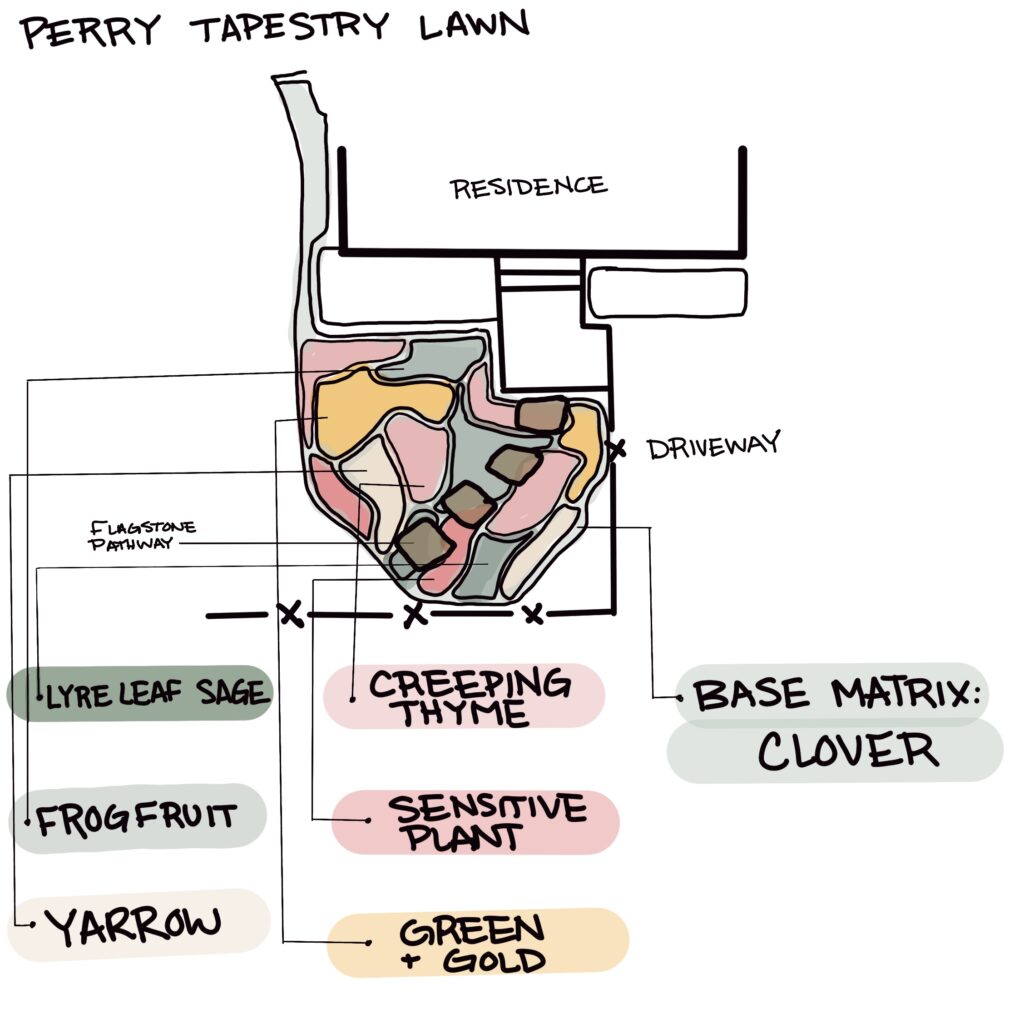The concept of a traditional lawn—a monoculture of neatly trimmed grass—is increasingly under scrutiny… and rightfully so! These lawns require a ton of input and often leave the soil depleted and the surrounding ecosystem off balance. Instead, we encourage our clients to shift towards tapestry lawns, which are rich in biodiversity and offer numerous ecological benefits. Tapestry lawns, which incorporate a variety of plant species, not only enhance the aesthetic appeal of outdoor spaces but also contribute significantly to biodiversity, soil health, and sustainable living. These spaces create a harmonious balance between human needs and the natural world. They often include a blend of herbs, clover, wildflowers, and other ground covers that form a colorful, textured landscape.
Let’s explore how these innovative lawn styles embody our values as permaculturists as we help to encourage others to participate in Earth’s return to health.
One of the primary benefits of a tapestry lawn is its contribution to biodiversity. Traditional lawns, with their reliance on a single type of grass, offer little to no habitat for wildlife. In contrast, a tapestry lawn, featuring an array of grasses, clovers, wildflowers, and herbs, creates a vibrant ecosystem that supports a variety of insects, birds, and other wildlife.
- Insect Diversity: Different plants attract different insects, which play crucial roles in pollination and pest control. For instance, flowering plants like clover and wildflowers attract bees, butterflies, and other pollinators, which are essential for the health of many plants and crops.
- Bird Habitat: A diverse lawn provides food and nesting material for birds. Seed-producing plants can sustain birds, while various insects serve as a food source.
- Microbial Life: Below the surface, plant diversity fosters a rich community of microbes, fungi, and other soil organisms. These microorganisms are vital for nutrient cycling and plant health.
Healthy soil is the foundation of any thriving ecosystem, and tapestry lawns excel at enhancing soil quality. Here’s how:
- Nutrient Cycling: Different plants have varying nutrient needs and uptake rates. By growing a mix of species, nutrients are more evenly distributed and utilized. Deep-rooted plants bring nutrients from deeper soil layers to the surface, making them available to other plants.
- Soil Structure: The diverse root systems in a polyculture lawn improve soil structure by creating a network of channels that enhance aeration and water infiltration. This reduces erosion and compaction, common issues in monoculture lawns.
- Organic Matter: Leaf litter and plant residues from a variety of species contribute to a richer layer of organic matter. This organic matter is essential for maintaining soil fertility and water retention.

We’ve been excited to see interest from our clients and created EcoLawns, in part, to educate, create and maintain these thriving landscapes. Good news – we are currently taking on clients, you can book a call to find out more. A few pointers as you begin your tapestry lawn journey!
- Assess Your Lawn: Understand your soil type, sunlight, and moisture levels. Conduct a soil test to determine pH and nutrient levels.
- Choose Plant Species: Select a mix of grasses, legumes, and wildflowers suited to your local climate and soil conditions. Consider native species, as they are well-adapted and support local wildlife.
- Prepare the Soil: Remove existing grass and weeds – we suggest sheet mulching. Amend the soil with compost to improve fertility and structure.
- Planting: Sow seeds or plant plugs in a mix that ensures good coverage and variety. Water thoroughly and keep the soil moist until the plants are established.
- Maintenance: Reduce mowing frequency to allow plants to flower and seed. Avoid synthetic fertilizers and pesticides, opting instead for organic amendments and natural pest control methods.
Transitioning to a tapestry lawn is a rewarding journey that aligns with permaculture principles and promotes environmental stewardship. By fostering biodiversity and enhancing soil health, tapestry lawns offer a sustainable alternative to traditional lawns, creating vibrant, resilient landscapes that benefit both people and the planet. Embrace the diversity, and let your lawn become a thriving ecosystem in its own right.



